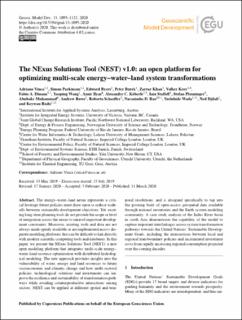| dc.contributor.author | Vinca, Adriano | |
| dc.contributor.author | Parkinson, Simon | |
| dc.contributor.author | Byers, Edward | |
| dc.contributor.author | Burek, Peter | |
| dc.contributor.author | Khan, Zarrar | |
| dc.contributor.author | Krey, Volker | |
| dc.contributor.author | Diuana, Fabio A. | |
| dc.contributor.author | Wang, Yaoping | |
| dc.contributor.author | Ilyas, Ansir | |
| dc.contributor.author | Köberle, Alexandre C. | |
| dc.contributor.author | Staffell, Iain | |
| dc.contributor.author | Pfenninger, Stefan | |
| dc.contributor.author | Muhammad, Abubakr | |
| dc.contributor.author | Rowe, Andrew | |
| dc.contributor.author | Schaeffer, Roberto | |
| dc.contributor.author | Rao, Narasimha D. | |
| dc.contributor.author | Wada, Yoshihide | |
| dc.contributor.author | Djilali, Ned | |
| dc.contributor.author | Riahi, Keywan | |
| dc.date.accessioned | 2022-05-03T09:13:43Z | |
| dc.date.available | 2022-05-03T09:13:43Z | |
| dc.date.created | 2020-11-12T12:39:02Z | |
| dc.date.issued | 2020 | |
| dc.identifier.citation | Geoscientific Model Development. 2020, 13 (3), 1095-1121. | en_US |
| dc.identifier.issn | 1991-959X | |
| dc.identifier.uri | https://hdl.handle.net/11250/2993821 | |
| dc.description.abstract | The energy–water–land nexus represents a critical leverage future policies must draw upon to reduce trade-offs between sustainable development objectives. Yet, existing long-term planning tools do not provide the scope or level of integration across the nexus to unravel important development constraints. Moreover, existing tools and data are not always made openly available or are implemented across disparate modeling platforms that can be difficult to link directly with modern scientific computing tools and databases. In this paper, we present the NExus Solutions Tool (NEST): a new open modeling platform that integrates multi-scale energy–water–land resource optimization with distributed hydrological modeling. The new approach provides insights into the vulnerability of water, energy and land resources to future socioeconomic and climatic change and how multi-sectoral policies, technological solutions and investments can improve the resilience and sustainability of transformation pathways while avoiding counterproductive interactions among sectors. NEST can be applied at different spatial and temporal resolutions, and is designed specifically to tap into the growing body of open-access geospatial data available through national inventories and the Earth system modeling community. A case study analysis of the Indus River basin in south Asia demonstrates the capability of the model to capture important interlinkages across system transformation pathways towards the United Nations' Sustainable Development Goals, including the intersections between local and regional transboundary policies and incremental investment costs from rapidly increasing regional consumption projected over the coming decades. | en_US |
| dc.language.iso | eng | en_US |
| dc.publisher | European Geosciences Union | en_US |
| dc.rights | Navngivelse 4.0 Internasjonal | * |
| dc.rights.uri | http://creativecommons.org/licenses/by/4.0/deed.no | * |
| dc.title | The NExus Solutions Tool (NEST) v1.0: An open platform for optimizing multi-scale energy-water-land system transformations | en_US |
| dc.title.alternative | The NExus Solutions Tool (NEST) v1.0: An open platform for optimizing multi-scale energy-water-land system transformations | en_US |
| dc.type | Peer reviewed | en_US |
| dc.type | Journal article | en_US |
| dc.description.version | publishedVersion | en_US |
| dc.source.pagenumber | 1095-1121 | en_US |
| dc.source.volume | 13 | en_US |
| dc.source.journal | Geoscientific Model Development | en_US |
| dc.source.issue | 3 | en_US |
| dc.identifier.doi | 10.5194/gmd-13-1095-2020 | |
| dc.identifier.cristin | 1847379 | |
| cristin.ispublished | true | |
| cristin.fulltext | original | |
| cristin.qualitycode | 2 | |

